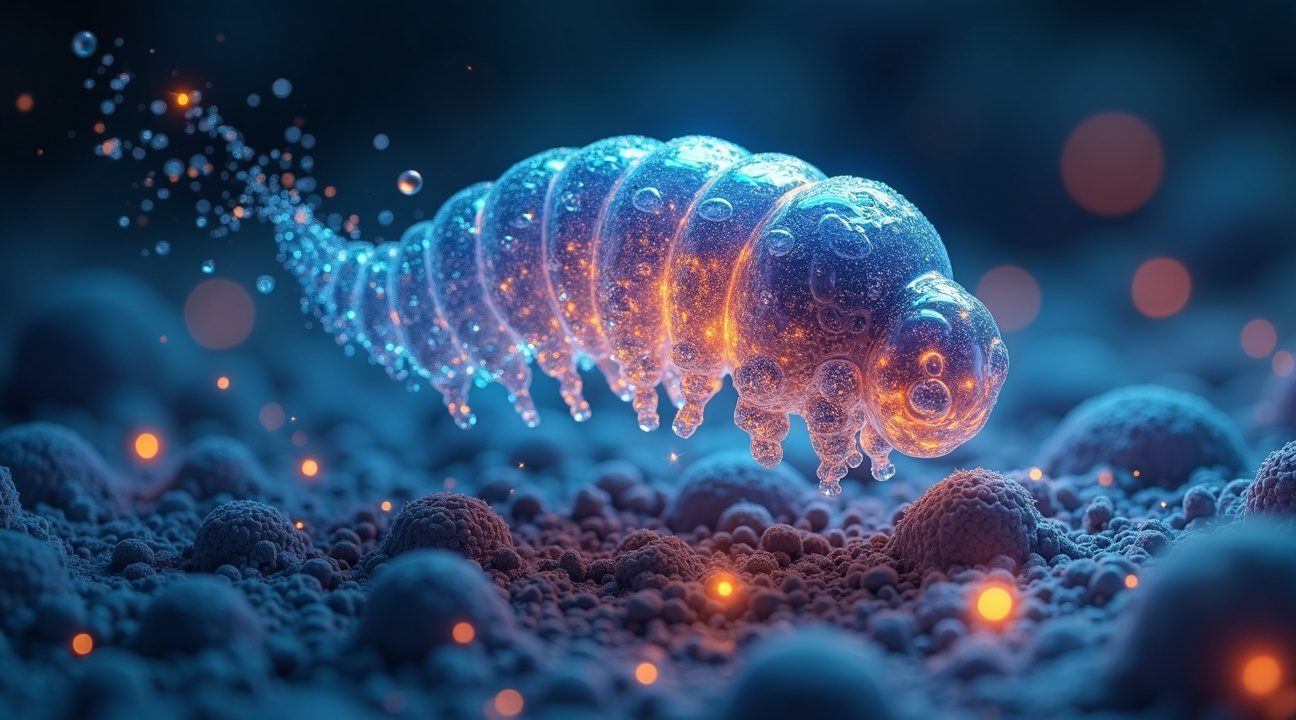Chinese researchers have achieved a pioneering feat by integrating tardigrade DNA into human embryonic stem cells through CRISPR technology, resulting in a stunning 40% reduction in DNA damage under radiation exposure.
Key Takeaways
- Scientists integrated the tardigrade Dsup protein into human stem cells, significantly enhancing their ability to protect against radiation-induced DNA damage and oxidative stress.
- Modified human cells demonstrated a 40% reduction in DNA damage compared to unmodified counterparts, all while preserving normal cellular functions and their ability to proliferate.
- Potential medical applications include breakthroughs in cancer therapy, astronaut protection during deep space missions, and interventions targeting age-related cellular degradation.
- The research employed CRISPR/Cas9 gene-editing tools to accurately incorporate the Dsup protein gene—one of the 14,700+ genes found in tardigrades, 30% of which are wholly unique to their species.
- While the findings are promising, further extensive research, including long-term safety evaluations and ethical review, is necessary before transitioning to human clinical use.
The Role of Tardigrades in Genetic Innovation
The microscopic tardigrade, often referred to as a “water bear,” has long fascinated scientists for its extreme resistance to environmental stressors. Its Dsup (damage suppressor) protein is especially notable for its ability to protect DNA from radiation and oxidative damage. By replicating this mechanism in human cells, researchers are venturing into transformative genetic engineering with wide-reaching implications.
What This Means for the Future
This discovery opens new frontiers in biomedical science and space exploration. With successful replication and safety validations, research like this could revolutionize how we approach radiation therapy in medicine and the viability of human life in extraterrestrial environments.
As science pushes the boundaries between species at a genetic level, careful oversight and robust ethical frameworks will be essential to navigate this bold new world.
Scientists Successfully Merge Tardigrade DNA with Human Stem Cells Using CRISPR Technology
Chinese researchers have achieved a groundbreaking milestone by successfully inserting tardigrade DNA into human embryonic stem cells. This extraordinary achievement represents a major leap forward in genetic engineering and cross-species gene transfer technology.
The CRISPR Revolution in Action
The team utilized CRISPR/Cas9 technology to extract the Dsup gene from tardigrades and integrate it directly into human embryonic stem cell line hESC-H9. This precision gene-editing tool allowed scientists to make targeted modifications with unprecedented accuracy, opening new possibilities for enhancing human cellular resilience.
Dsup protein stands as one of nature’s most remarkable protective mechanisms. Found exclusively in tardigrades, this unique protein demonstrates exceptional ability to shield DNA from radiation-induced damage and oxidative stress. The protein’s protective qualities have fascinated researchers for years, particularly its capacity to neutralize free radicals that typically cause cellular destruction.
Revolutionary Applications and Future Implications
This breakthrough offers tremendous potential for various medical applications. Scientists believe the enhanced radiation tolerance could prove invaluable for several scenarios:
- Cancer treatment patients undergoing radiation therapy could benefit from reduced cellular damage
- Space exploration missions where astronauts face intense cosmic radiation exposure
- Nuclear accident response where workers encounter dangerous radiation levels
- Age-related cellular deterioration prevention through enhanced DNA protection
The successful integration demonstrates how extremophile organisms can contribute to human health advancement. Tardigrades, often called water bears, survive conditions that would instantly kill most life forms, including extreme radiation, temperature fluctuations, and even the vacuum of space.
I find it fascinating how scientific innovation continues advancing at such a rapid pace. This particular research represents a convergence of synthetic biology and practical medical applications.
The implications extend far beyond immediate medical benefits. This work establishes important precedents for future genetic modifications that could enhance human resistance to environmental hazards. The research team’s success with hESC-H9 cells provides a foundation for further studies examining how tardigrade-derived genetic material functions within human cellular environments.
Scientists emphasize that this research remains in early experimental phases. However, the successful gene transfer opens discussions about enhancing human biological capabilities through carefully selected genetic modifications from other species. The Dsup protein’s integration into human stem cells marks just the beginning of what could become routine enhancement procedures in future medicine.
Human Cells Show 40% Reduction in DNA Damage After Genetic Modification
Chinese researchers achieved a breakthrough when they successfully transfected human stem cells with tardigrade DNA, resulting in dramatically enhanced cellular resilience. The modified cells demonstrated a remarkable 40% reduction in DNA damage compared to their unmodified counterparts after exposure to radiation. This significant improvement suggests that incorporating genetic material from these microscopic survivors could revolutionize how we protect human cells from environmental hazards.
The experiment specifically targeted acute radiation syndrome, a condition that poses serious risks to astronauts, nuclear workers, and cancer patients undergoing radiation therapy. Scientists focused on the tardigrade’s Dsup protein, which acts as a powerful damage suppressor within cells. When human stem cells expressed this protein, they showed enhanced resistance to radiation exposure while maintaining their proliferative capacity – the ability to divide and multiply effectively.
Enhanced Cellular Protection Mechanisms
The research revealed that human cells expressing the tardigrade Dsup protein developed superior tolerance to oxidative stress, one of the primary causes of cellular aging and disease. Oxidative stress occurs when harmful molecules called free radicals overwhelm the cell’s natural defense systems, leading to DNA damage and cellular dysfunction. These modified cells demonstrated improved cell viability even under harsh conditions that would typically cause significant harm.
The protective effects extend beyond simple survival. Enhanced cells maintained their normal functions while simultaneously activating advanced DNA repair mechanisms. This dual benefit suggests that tardigrade DNA integration doesn’t just help cells survive damage – it actively prevents damage from occurring in the first place. The damage suppressor protein appears to create a protective shield around cellular components, particularly the nucleus where DNA resides.
Previous research supports these findings. A 2021 Italian study using kidney cells found similar increases in DNA repair gene expression when Dsup was introduced into human cells. That earlier work established the foundation for understanding how tardigrade proteins could enhance human cellular resilience. The Italian researchers documented improved cellular responses to various stress factors, confirming that this approach holds promise across different cell types.
The implications for medical applications are substantial:
- Cancer Treatment: Incorporating tardigrade DNA could potentially protect healthy tissues while allowing targeted cancer cells to receive therapeutic radiation doses.
- Space Exploration: Astronauts facing cosmic radiation during long-duration space missions might benefit from enhanced cellular protection.
Scientists continue exploring how this genetic modification affects long-term cellular behavior. Early results indicate that the enhanced protection doesn’t compromise normal cellular functions or cause unwanted mutations. The modified cells maintain their original characteristics while gaining extraordinary resilience capabilities. This balance between protection and normal function represents a crucial advancement in genetic engineering applications.
The research connects to broader scientific discoveries about extreme survival mechanisms in nature. Just as scientists have studied how certain organisms can survive in unusual conditions, tardigrades represent the ultimate example of biological resilience. These microscopic animals can withstand radiation levels thousands of times higher than what would kill humans, temperatures approaching absolute zero, and the vacuum of space.
Understanding how tardigrade DNA functions in human cells opens new possibilities for:
- Treating genetic disorders
- Protecting against environmental toxins
- Extending healthy cellular lifespan
The 40% reduction in DNA damage represents just the beginning of what might be possible. Future research will likely explore combining multiple tardigrade proteins or optimizing the integration process for even greater protective effects.
This breakthrough demonstrates how studying extreme organisms can lead to practical medical applications. The successful integration of tardigrade DNA into human cells proves that nature’s most resilient creatures hold secrets that could transform human health and longevity.
The Extraordinary Resilience of Tardigrades Revealed Through New Species Discovery
Tardigrades represent nature’s ultimate survivors, and the recent discovery of Hypsibius henanensis by Chinese scientists has unveiled remarkable insights into their extraordinary resilience mechanisms. These microscopic creatures can withstand radiation doses up to 2,000 grays—levels that would instantly kill most other organisms—while also surviving extreme temperatures, complete dehydration, and even the harsh vacuum of space.
Genetic Arsenal Behind Superhuman Survival
The newly studied tardigrade species possesses an impressive genetic toolkit consisting of 14,701 genes, with approximately 30% being completely unique to tardigrades. This genetic uniqueness explains their unparalleled survival capabilities across multiple extreme conditions. Scientists have discovered that exposure to radiation triggers the activation of over 2,800 genes specifically dedicated to DNA repair and cellular protection, creating a comprehensive defense system that surpasses anything found in other organisms.
Central to this survival mechanism is the Dsup protein, which functions as a natural DNA shield. During experiments, researchers found that this protein reduces radiation-induced DNA damage by approximately 40% in human cells, demonstrating its potential for medical applications. The protein works alongside other specialized genes involved in:
- DNA repair
- Antioxidant production
- Immune response
Together, these mechanisms create multiple layers of protection against cellular damage.
Revolutionary Applications in Human Medicine
The implications of tardigrade research extend far beyond understanding these tiny creatures. Scientists are now exploring how tardigrade genes might enhance human cellular resistance to radiation and other stressors. The process of cryptobiosis—where tardigrades essentially suspend all biological processes to survive extreme conditions—offers insights into potential medical treatments and life extension technologies.
Research teams have successfully demonstrated that introducing tardigrade DNA elements into human cells can provide measurable protection against radiation damage. This breakthrough opens possibilities for:
- Protecting astronauts during long-space missions
- Enhancing cancer treatment protocols
- Developing new approaches to age-related cellular damage
The antioxidant pigments produced by tardigrades also contribute to their resilience, providing additional protection against oxidative stress that typically damages cells. These compounds work in conjunction with the DNA repair mechanisms to maintain cellular integrity under conditions that would be fatal to most life forms.
Understanding these microscopic survivors continues to inspire innovations in biotechnology and medicine. While the concept of enhancing human resilience through genetic modification might sound like science fiction, DNA research advances are making such possibilities increasingly realistic.
The discovery of Hypsibius henanensis and its genetic secrets represents a significant step forward in understanding biological resilience. Scientists continue to study how these creatures achieve their remarkable survival capabilities, with each discovery potentially leading to new medical treatments and protective technologies.
Current research focuses on isolating and replicating the specific mechanisms that make tardigrades so resilient. The ability to survive in space has particular relevance as humanity expands its presence beyond Earth, making tardigrade research crucial for future space exploration missions.
These findings also highlight the incredible diversity of survival strategies that exist in nature. From unusual biological phenomena to advanced adaptive technologies, the natural world continues to provide inspiration for scientific advancement and human innovation.
The ongoing study of tardigrade genetics promises to unlock new understanding of cellular protection mechanisms, potentially revolutionizing how we approach human health challenges and extreme environment survival. Each gene sequenced and protein analyzed brings researchers closer to harnessing these remarkable survival capabilities for human benefit.

Breakthrough Could Transform Cancer Treatment and Space Exploration
I find this groundbreaking research opens doors to revolutionary applications that could reshape how we approach some of humanity’s greatest medical and exploratory challenges. The successful integration of tardigrade DNA into human cells represents a significant leap forward in biotechnology, with implications extending far beyond the laboratory.
Medical Applications Show Immediate Promise
Cancer patients undergoing radiation therapy face severe cellular damage as a consequence of treatment. This research offers hope for developing protective therapies that could shield healthy cells while targeting malignant ones. The tardigrade’s extraordinary DNA repair mechanisms could be harnessed to create treatments that significantly reduce radiation-induced side effects.
Scientists working on this project believe the applications extend to multiple areas of medicine:
- Enhanced protection against cellular aging through improved DNA repair
- Reduced inflammation responses that contribute to chronic diseases
- Potential treatments for neurodegenerative conditions like Alzheimer’s and Parkinson’s
- Improved stem cell differentiation for regenerative medicine
- Better outcomes for patients receiving chemotherapy or radiation
The implications for space exploration are equally compelling. Astronauts on long-duration missions face constant bombardment from cosmic radiation, which damages DNA and increases cancer risk. I see potential for this technology to create biological shields that protect space travelers during extended journeys to Mars or beyond. Future missions could benefit from crew members who possess enhanced resistance to radiation damage, making deep space exploration significantly safer.
Safety and Ethical Considerations Demand Careful Study
Despite the exciting possibilities, researchers emphasize that extensive safety studies remain essential before any human applications. Cross-species gene transfer raises important bioethical questions about the boundaries of human genetic modification. The long-term effects of incorporating tardigrade DNA into human cells aren’t fully understood, requiring years of additional research.
Gene editing safety protocols must evolve to address these unprecedented modifications. Scientists stress that while the laboratory results show promise, the path to clinical applications requires rigorous testing and regulatory approval. I believe the scientific community recognizes the need for transparent dialogue about the ethical implications of such dramatic genetic modifications.
Current research focuses on understanding how tardigrade proteins interact with human cellular mechanisms. The complexity of integrating foreign DNA systems into human biology presents technical challenges that scientists are actively addressing. These studies will determine whether the protective benefits can be achieved without unintended consequences.
Medical and biotechnology applications represent the most realistic near-term goals according to expert opinions. Developing targeted therapies for specific diseases or creating protective treatments for high-risk medical procedures appears more achievable than wholesale genetic enhancement. I expect to see focused applications emerge first, such as treatments for patients with genetic disorders affecting DNA repair.
This research connects to broader scientific mysteries, much like how scientists explore unusual biological phenomena or investigate possibilities in genetic science. The intersection of biology and technology continues to produce remarkable discoveries that challenge our understanding of life’s limits.
The potential for creating more resilient human cells could revolutionize how we approach both terrestrial health challenges and space exploration. However, the scientific community maintains that responsible development requires balancing innovation with safety, ensuring that these powerful new capabilities serve humanity’s best interests while respecting ethical boundaries.
Research teams worldwide are now examining similar approaches, suggesting this breakthrough could catalyze a new field of study combining extremophile biology with human medicine. The coming years will determine whether this promising start translates into practical treatments that transform lives.

Media Sensationalism Creates “Super Soldier” Myths Around Scientific Research
The dramatic headlines about “super soldiers” that circulated globally started with initial reports from outlets like South China Morning Post and Popular Mechanics, but these claims lack foundation in the actual scientific paper. I’ve observed how these sensational narratives took on a life of their own, creating a significant gap between what researchers actually accomplished and what the public believed happened.
The validated experiment focused exclusively on molecular and biomedical research applications. Scientists injected human embryonic kidney cells with tardigrade damage suppressor (Dsup) protein to study cellular resilience mechanisms. This work aimed to understand how certain biological processes might protect cells from radiation damage or other stressors. Military enhancement applications never appeared in the research objectives or conclusions.
How Speculation Transforms Into “Fact”
Western media outlets amplified these claims before proper verification occurred. I find this pattern troubling because it demonstrates several critical failures in science communication:
- Translation issues that can distort original research findings
- Journalistic pressure to create compelling narratives from complex scientific work
- Lack of direct consultation with the original research teams
- Insufficient emphasis on peer review processes before publication
The transformation from legitimate cellular research to “super soldier” mythology reveals how speculative claims can overwhelm factual reporting. Academic skepticism plays a crucial role in separating verified results from wishful thinking or sensational stories that capture public attention.
Cross-species genetic engineering research often becomes a target for exaggerated claims because the public struggles to understand the technical limitations and practical applications. The tardigrade study exemplifies how scientific curiosity about DNA manipulation gets misinterpreted as military development when no such connection exists.
Research verification requires examining primary literature rather than relying on secondary reports. I recommend that anyone interested in understanding scientific breakthroughs should look for peer-reviewed publications and official institutional statements rather than trusting initial media coverage. The peer review process, while imperfect, provides essential quality control that popular media often bypasses.
The “super soldier” narrative particularly appeals to audiences because it combines legitimate scientific advancement with science fiction elements that feel almost plausible. Military applications of biological research do exist, but they typically involve medical treatments for service members rather than enhancement technologies that create superhuman capabilities.
Academic institutions bear responsibility for clear communication about their research goals and limitations. Scientists working on cross-species genetic engineering need to anticipate how their work might be misrepresented and proactively address potential misconceptions. The gap between laboratory results and practical applications often spans decades, making immediate military deployment scenarios highly unlikely.
Translation accuracy becomes critical when research originates in non-English speaking countries. Subtle differences in scientific terminology can dramatically alter public understanding of research scope and implications. I’ve noticed that technical terms often lose precision during translation, creating opportunities for misinterpretation.
The speed of modern information sharing means that initial reports can spread faster than corrections or clarifications. Social media amplifies this effect, allowing dramatic claims to reach millions before scientists can respond with accurate information. This dynamic puts additional pressure on researchers to communicate clearly from the outset.
Media exaggeration around genetic research reflects broader public fascination with advanced technologies that seem to blur the line between current capabilities and future possibilities. The tardigrade study represents genuine scientific progress in understanding cellular protection mechanisms, but this achievement doesn’t require superhuman enhancement narratives to be significant.
Future reporting on similar research would benefit from including multiple expert perspectives and emphasizing the distinction between immediate findings and speculative applications. The scientific community continues working to bridge the communication gap between laboratory discoveries and public understanding.

Sources:
Nature reporting via ZME Science — “Scientists discover new Tardigrade species that may reveal the secrets of radiation resistance”
Future of Being Human — “Did Chinese scientists gene edit tardigrade DNA into human stem cells?”
Threads — “Chinese scientists have done a bold experiment by adding tardigrade DNA into human embryonic stem cells”
Popular Mechanics — “Scientists Put Tardigrade DNA Into Human Stem Cells: Here’s Why”
Tribune — “Chinese scientists decode tardigrades’ radiation resistance, aims for human protection”


